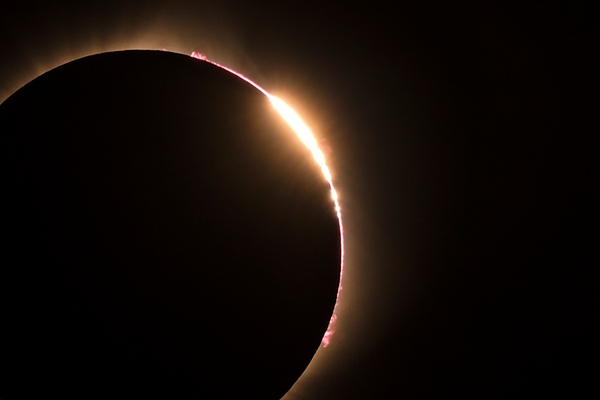Here’s how to pick a viewing spot, stay on top of the weather and pack the right gear to see the total solar eclipse on April 8
Thank you for reading this post, don't forget to subscribe!
john finney photography/Getty Images
This article is part of a special report on the total solar eclipse that will be visible from parts of the U.S., Mexico and Canada on April 8, 2024.
CONCAN, Tex.—After months of waiting, planning and anticipating, the eclipse is nearly upon us. This rare heavenly alignment will be a marvel to look at for anyone lucky enough to have clear skies at the time. For a few minutes, the face of the moon will perfectly overlap that of the sun from our perspective on Earth, blocking out most of the light from our star and leaving only the wispy white glow of the sun’s outer atmosphere, called the corona.
This phase, called, totality, will be dramatic. The sky will get completely dark, like the dead of night, the temperature will drop, and birds, insects and other creatures may react strangely. Just as you get used to the sight, the moon will edge away, letting stunningly bright beads of light through, and then back off to reveal more and more of the sun’s disk.
On supporting science journalism
If you’re enjoying this article, consider supporting our award-winning journalism by subscribing. By purchasing a subscription you are helping to ensure the future of impactful stories about the discoveries and ideas shaping our world today.
“The most exciting parts of a total solar eclipse are the sudden twilight effect that occurs in the middle of the day, the appearance of the corona and sometimes large, bright features erupting from the sun’s surface called prominences,” says Hagai Perets, an astrophysicist at the Technion–Israel Institute of Technology. “Stars and planets, which you can usually see only at night, might also be briefly visible.”
Even if you won’t be along the path of totality, you’ll still be in for a show. A partial eclipse—the sight of the sun partly covered by the dark face of the moon—is cool in its own right, and during this event, such an eclipse will be visible across most of the U.S.
To catch the best possible view of the event, here’s how to prepare:
Pick the best place to view to eclipse: The ideal spot is along the path of totality, where you’ll see the maximum coverage of the sun by the moon. Totality will begin over Sinaloa, Mexico, cross over many major U.S. cities—including Dallas, Indianapolis, Cleveland, Buffalo, N.Y., and Burlington, Vt.—and at last pass over the Canadian island of Newfoundland.
Check the weather: A lot will depend on the weather, and eclipse forecasts are changing by the minute. You might want to keep your plans flexible and pick an exact location based on the lowest chances of cloud cover. “You can select locations that give you the best chance of clear skies, but there are never any guarantees, as we are finding right now,” says eclipse chaser Kate Russo, author of Total Addiction: The Life of an Eclipse Chaser. “I always have a plan A and a plan B, sometimes a plan C.” It’s also smart to keep an eye on traffic patterns and public safety advisories for the areas you’re considering.
Pack the right gear: The most important thing to pack for any eclipse viewing is a pair of eclipse glasses, which will shield your eyes from the harmful rays of the sun during the partial eclipse leading up to, and following, totality. (You can take them off during full totality because the sun’s direct light will be blocked, and the corona’s glow won’t hurt your eyes.) And special solar filters are needed to safely view the sun with cameras, telescopes and binoculars. If you’re hoping to take photographs of the event, check out our guide to eclipse photography gear. And of course, take lots of snacks and water.
I, like many Americans, got hooked on eclipses during the 2017 total eclipse over the U.S., my first sighting. Rather than crossing the experience off my bucket list, the spectacle was so exhilarating that I resolved to see a total eclipse again as soon as I possibly could. “It’s like a compulsion,” Russo says. “It was very strong after I saw my first eclipse, then second, then third, up until my seventh or eighth. It remains very strong, but I also have a compulsion to help others experience totality, which is what drives the work I do on supporting community eclipse planning and sharing the experience of totality with others.”
The eclipse won’t just be a great show—it’s a special opportunity for scientists to learn more about the sun. “There are a lot of open questions about the sun even though it is our star,” says Amir Caspi, a solar physicist at the Southwest Research Institute. He and his team will be capturing footage of the eclipse by chasing it with NASA jets outfitted with special cameras. The researchers hope to learn more about the physics of the corona, which is surprisingly hot—about 200 times warmer than the surface. “It’s like when you walk away from a campfire, somehow it gets warmer,” Caspi says.
You, too, can participate in science during the eclipse—several projects are recruiting volunteers to help gather data during the event. Survey some of the crowdsourced eclipse research options here.
And if you aren’t able to make it to the path of totality or clouds foil your plans, you can always catch an online stream of the eclipse. As soon as this one’s over, it’ll be time to start planning for the next eclipse, too!

